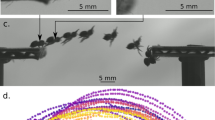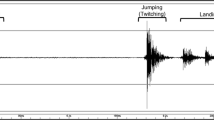Abstract
MOST zoologists would consider a jumping Diplopod to be a highly unlikely animal. Whilst one of us (J. G. B.) was in Sierra Leone recently, however, he collected some millipedes which can perform a succession of four or five short hops. The millipedes belong to the sub-order Stemmiuloidea. The genus represented in Sierra Leone is Diopsiulus Silvestri, of which there are several species, all superficially similar, which all have this characteristic jumping behaviour. Cook1, writing on neotropical species belonging to the sub-order, reported that the animals “frequently throw themselves several inches when disturbed”, and wrote that the collector of a species in Ceylon (D. ceylonicus) reported to Pocock that the animals were saltatory. Cook wrote that the “apparent jumping motion is caused by vigorous wriggling of the body”.
Similar content being viewed by others
References
Cook, O. F., Am. Nat., 29, 1111 (1895).
Manton, S. M., J. Linn. Soc. (Zool.), 42, 299 (1954).
Manton, S. M., J. Linn. Soc. (Zool.), 43, 487 (1958).
Author information
Authors and Affiliations
Rights and permissions
About this article
Cite this article
EVANS, M., BLOWER, J. A Jumping Millipede. Nature 246, 427–428 (1973). https://doi.org/10.1038/246427a0
Received:
Issue Date:
DOI: https://doi.org/10.1038/246427a0
- Springer Nature Limited





